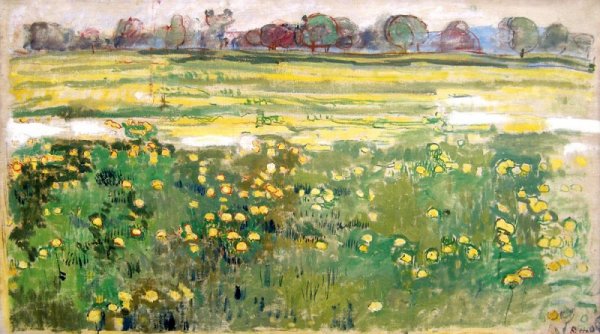
Ferdinand Hodler, Landscape from Bonaville, oil on canvas, inv. no. 4508, National Gallery of B&H
The swiss painter Ferdinand Hodler was born in Berne in 1853 and died in 1918. He spent his whole life in Switzerland, although his fame spread throughout the Europe during his lifetime. At the end of the 19th century he became popular in Paris, where he exhibited twice at the Paris Salon, and at the beginning of the 20th century he achieved great success at the Vienna Secession exhibitions. At that time, he was declared a genius of large-scale painting. In 1905 he exhibited in a special hall at the Berlin Secession. Fame, wealth and social standing gave Hodler material comfort but not happiness. He lived in the shadow of death from early childhood, when he lost his parents and five siblings, until the end of his life. In addition, the political events of the early 20th century often drove Hodler to protest. His Truth was a direct response to the Dreyfus Affair, and his name can be found among the signatures of artists protesting against the bombardment of Rheims cathedral. Hodler must have been fully aware of the possible consequences of his actions, and these indeed followed: he was expelled from every German art society and his large composition Jena was covered.
After his death in 1918 Hodler became the greatest of national painters, but his fame in Europe slowly began to fade. Only in the last few decades, with Secession as an artistic style gaining in importance, have Europe and the rest of the world rediscovered Hodler through a series of exhibitions of his work. And while his work is being studied from different angles, the prices of his canvases have increased.
Hodler began drawing early. He was self-taught, although he did take classes with Bartelémy, a student of Ingres. In any case Hodler developed a completely original style without the help of any great idols; this was later imitated by many, without great success. From Bartelémy he learned about the significance of contour and drawing, which for a long time dominated his works. As already mentioned, he enjoyed the fruits of his work and success while he was still alive; at the same time, however, he was a frequent target of criticism and prejudice. He also experienced ups and downs in his private life. He married twice. Practically nothing is known about his first wife Bertha Stuck. His second wife, who was also called Bertha (Jack), outlived Hoodler, who was survived by two children: a son Hector from his relationship with Augustine Dupin, and a daughter Paulette from his relationship with seamstress Valentine Godé Darel. After Hodler’s death, his wife Bertha adopted Paulette, thereby providing for herself.
As we can see, Hodler was not immune to feminine charms. It is practically impossible to ascertain how many female models passed through the painter’s studio and how many of them were “more than just models” to Hodler. Only a few names have been recorded for posterity. Apart from his wife Bertha, who often posed for him, particularly for allegorical compositions and works of stylised and in places even exaggerated Secessionist sharpness and simplicity. Hodler’s models were Valentine Godé Darel, Giulia Leonardi and Jeanne Charles Cerani Ćišić.
